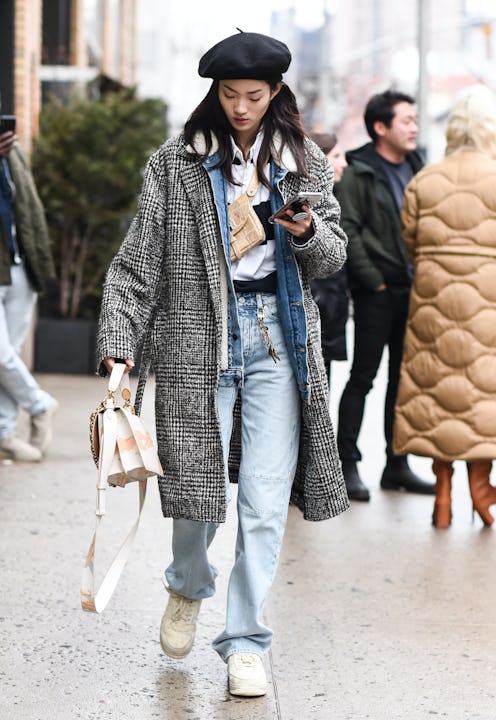(Trends)
Why The Beret Never Goes Out Of Style
Worn by artists, revolutionaries, and many chic Parisians.

The iconography of French style can be encapsulated with one simple hat: the beret. For eras past and present, this quintessential chapeau has been a symbol of a country that embraces intellect and leisure. However, despite your inclination to swiftly associate this accessory with the Parisian lifestyle, there is much more to consider when it comes to the history of berets. Naturally, its presence in French culture runs deep (more on that in a moment) but throughout the years — and centuries, for that matter — this hat has become a sort of contradiction. On one end of the spectrum, the beret has been worn by artists, style icons, film stars, and bon vivants alike. On the other, it's a unifying piece harnessed by political revolutionaries and armed forces. You'll be hard-pressed to think of any other hat that's as profoundly enmeshed in the complexities of history and life. In essence, a beret is so much more than just a beret.
Ahead, learn about a few key points on this hat's fascinating timeline while hearing about its longstanding importance from the last remaining beret maker in France, whose business dates back to 1840. Oh, and if by the end you're itching for your very own beret, be sure to shop the picks below, too. C'est tout!
We only include products that have been independently selected by TZR's editorial team. However, we may receive a portion of sales if you purchase a product through a link in this article.
History Of The Beret: Oloron-Sainte-Marie
Rosabelle Forzy is the CEO of Laulhère, the last-remaining artisan beret-maker in France. Since 1840, the company has been crafting its berets at the foot of the Pyrenees in southwestern France in a Bearnaise town named Oloron Sainte Marie. "The beret is a pastoral confection from the Pyrenees," Forzy tells TZR. "Oloron Sainte Marie is the beret's original city; located at the crossroads of many paths taken by shepherds leading their herds of sheep between mountains." Berets have been spotted in paintings that date back several centuries (some on the internet even attribute its origins to Noah — yes, the biblical one) but this pastoral history is arguably responsible for its mass popularity according to Forzy. "The beret and Oloron are an inseparable couple and for 180 years, the economic life of the city has been punctuated by berets," Forzy adds.
History Of The Beret: Armed Forces
Berets are implemented in the uniforms of armed forces around the globe. "The beret is an ally in the battlefield. It became part of the military uniform in France but eventually, for armies worldwide," Forzy says. The first group that may come to mind for many Americans is the United States Army Special Forces (aka Green Berets) but military berets are found everywhere from the Danish Jægerkorpset to the Spetsnaz Soviet Internal Troops.
History of the Beret: Political Revolutionaries
Another group genre that has close ties with the beret is the political revolutionary. "The beret is emblematic of non-conformism. It is worn by people who create, commit, militate, and resist," Forzy says. The Black Panthers are an example of a movement that used the beret as a symbol of revolution. Chairman Fred Hampton (who was recently portrayed by Daniel Kaluuya in Shaka King's Judas and The Black Messiah) is said to have been inspired to make the beret part of the Black Panther uniform upon watching a film that depicted members of the WWII French Resistance wearing berets. And you can't mention berets and revolutionaries without a nod to Argentine revolutionary Che Guevara, whose iconic photograph by Alberto Korda remains a portrait of revolution to this day.
History Of The Beret: Artists
Berets are the unofficial hat of choice for artists, especially if you belonged to groups like the Impressionists. Rembrandt, Monet, Picasso, Cézanne — the list of creatives who donned the headgear is vast and goes back centuries. Though it's unclear when this unassuming hat became representative of creativity, there's no undoing the association of beret and paintbrush.
History Of The Beret: French Staple
Naturally, berets and the French are inextricably linked. "The beret is iconic of French fashion," Forzy notes. "It's unisex, can be worn on all occasions, and works with all shapes of faces and hairstyles. C’est le chic à la francaise." Women who evoke this spirit include style icons like Brigitte Bardot, Coco Chanel, and Catherine Deneuve but there are modern examples of how to style this staple, including model Zoe Alayrangues and — of course — hoards of non-French women who appreciate the hat's chic associations.
History Of The Beret: Reimagined For Now
From 17th-century paintings to Beyoncé's Superbowl performance starring Black power berets, one thing is evident: This hat is entrenched with significance. By choosing to wear a beret you're not just emulating your favorite scene from Bonnie and Clyde, you're tapping into a rich history of cultural importance, something most other fashion items simply cannot offer.